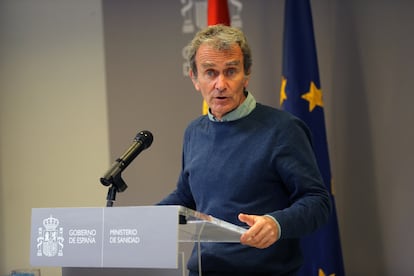Rise of fourth coronavirus wave in Spain begins to slow: ‘We’ve been able to respond’
The incidence rate, however, continues to increase in Madrid and the Basque Country, which are currently two of the worst-affected regions in the country

The rise of the fourth wave of the coronavirus pandemic in Spain has begun to slow. More importantly, this change has happened two weeks after the Easter vacation, which saw an increase in mobility and social activity due to national holidays. Health experts feared this would lead to a significant rise in new coronavirus cases and place Spain in the same difficult situation currently being seen in neighboring countries such as France, but instead the pace has slowed.
“We have to be pleased,” said Fernando Simón, the director of the Health Ministry’s Coordination Center for Health Alerts (CCAES), at a press conference on Monday to present the latest epidemiological report. “It does not appear that this fourth wave is going to be of a very large scale or come close to what we saw in the second and third [waves].” The health official reiterated the importance of maintaining preventive measures and taking the usual precautions, but was optimistic about the outlook. “The situation is good,” he said. “We have been able to respond and we can be satisfied, but we can’t lower our guard yet.”
It does not appear that this fourth wave is going to be of a very large scale or come close to what we saw in the second and third wavesFernando Simón, director of the Health Ministry’s Coordination Center for Health Alerts
According to the latest Health Ministry report, released on Monday evening, 21,071 new coronavirus cases and 121 deaths have been recorded since Friday. These figures cover Saturday and Sunday as data is not released on the weekends. The number of fatalities reported on Monday is slightly lower than what was recorded on the same day the previous two weeks.
Simón attributed the improved situation to three factors: “The work all the population is doing following safety precautions,” “the effort of institutions to apply restrictions” and “the vaccination drive, which is gradually increasing the population that is immune.”
Simón explained: “Right now, 20% of the total population has had at least one dose and 7.2% have had both.” If the number of people vaccinated is added to those who have had the virus and now have antibodies, a significant percentage of the Spanish population is protected from the coronavirus, he explained.
The improved situation comes just two weeks before the state of alarm in Spain is set to expire. For the past six months, the emergency situation has allowed the regions – which are in charge of the vaccination drive and controlling the pandemic in their territories – to introduce coronavirus restrictions on fundamental rights, such as nighttime curfews, without facing challenges in the courts. In recent weeks, several regional governments have called for the state of alarm to be extended beyond May 9, while health and legal experts have also warned it may be more difficult to apply preventive measures without the legal framework. Simón, however, said the state of alarm “is not needed,” if the current epidemiological situation and speed of the vaccination drive can be maintained.
According to the Health Ministry report, the 14-day cumulative number of cases per 100,000 inhabitants rose from 213 to 231 on Monday. This increase is partly due to the fact that the 14-day figure no longer includes days corresponding to Easter public holidays, when fewer tests are carried out.
The Health Ministry report recorded 21,071 new coronavirus cases and added 121 deaths to the official toll
The incidence rate, however, does reflect the overall trend of the pandemic. This data point is on the rise in Madrid and the Basque Country, which are currently two of the worst-affected regions in Spain. In the former, the 14-day cumulative number of cases per 100,000 inhabitants rose 71 points to 407 since last Monday, while in the latter, the figure jumped 80 points to 400 in the same period. Navarre is the region with the highest incidence rate, with 429 cases, but the figure has barely risen in the last seven days. On the other end of the spectrum, the regions with the lowest incidence rate are Murcia (68), the Balearic Islands (61) and Valencia (39).
Simón, however, warned that hospital and intensive care unit (ICU) admissions for Covid-19 are likely to continue to rise as these data points usually take one and two weeks, respectively, to reflect a change in trend. Pressure on hospitals in Catalonia, Valencia, the Balearic Islands and Murcia eased slightly on Monday, but Madrid continues to be under strain, with 41% of ICU beds occupied by Covid-19 patients. Only La Rioja, which has much fewer resources than Madrid, has a higher ICU occupancy rate, at 42%.
Simón warned that “an increase in ICU admissions is being detected” and that patients are also spending more time in hospital. He explained that these patients are on average younger and correspond to cases detected in previous weeks. According to the epidemiologist, the rise in hospital admissions is due to a number of factors, such as the fact that the coronavirus strain first detected in the United Kingdom – which causes more hospitalizations – is now the dominant variant in Spain. As for the longer hospital stays, he explained that the mortality rate has fallen, meaning patients less likely to die from Covid-19 are spending more time in hospital. This, in turn, has led to a rise in the average time spent in hospital, he said.
Although optimistic, Simón made sure to reiterate the importance of coronavirus safety measures before finishing the press conference. “Protective measures are important until we have a high percentage of the population vaccinated, between 65% and 70%,” he said.
English version by Melissa Kitson.
Tu suscripción se está usando en otro dispositivo
¿Quieres añadir otro usuario a tu suscripción?
Si continúas leyendo en este dispositivo, no se podrá leer en el otro.
FlechaTu suscripción se está usando en otro dispositivo y solo puedes acceder a EL PAÍS desde un dispositivo a la vez.
Si quieres compartir tu cuenta, cambia tu suscripción a la modalidad Premium, así podrás añadir otro usuario. Cada uno accederá con su propia cuenta de email, lo que os permitirá personalizar vuestra experiencia en EL PAÍS.
¿Tienes una suscripción de empresa? Accede aquí para contratar más cuentas.
En el caso de no saber quién está usando tu cuenta, te recomendamos cambiar tu contraseña aquí.
Si decides continuar compartiendo tu cuenta, este mensaje se mostrará en tu dispositivo y en el de la otra persona que está usando tu cuenta de forma indefinida, afectando a tu experiencia de lectura. Puedes consultar aquí los términos y condiciones de la suscripción digital.
More information
Últimas noticias
Rowan Atkinson tops Netflix at 70: ‘He’s as funny as ever’
Israeli recognition of Somaliland stirs up the Gulf
Tiger Woods turns 50: Will he continue playing on the PGA Tour or take a back seat?
The surreal journey of James Nnaji, the Barcelona youth player selected in the NBA Draft who ended up in the NCAA
Most viewed
- Oona Chaplin: ‘I told James Cameron that I was living in a treehouse and starting a permaculture project with a friend’
- Reinhard Genzel, Nobel laureate in physics: ‘One-minute videos will never give you the truth’
- Sinaloa Cartel war is taking its toll on Los Chapitos
- Why the price of coffee has skyrocketed: from Brazilian plantations to specialty coffee houses
- Chevy Chase, the beloved comedian who was a monster off camera: ‘Not everyone hated him, just the people who’ve worked with him’











































